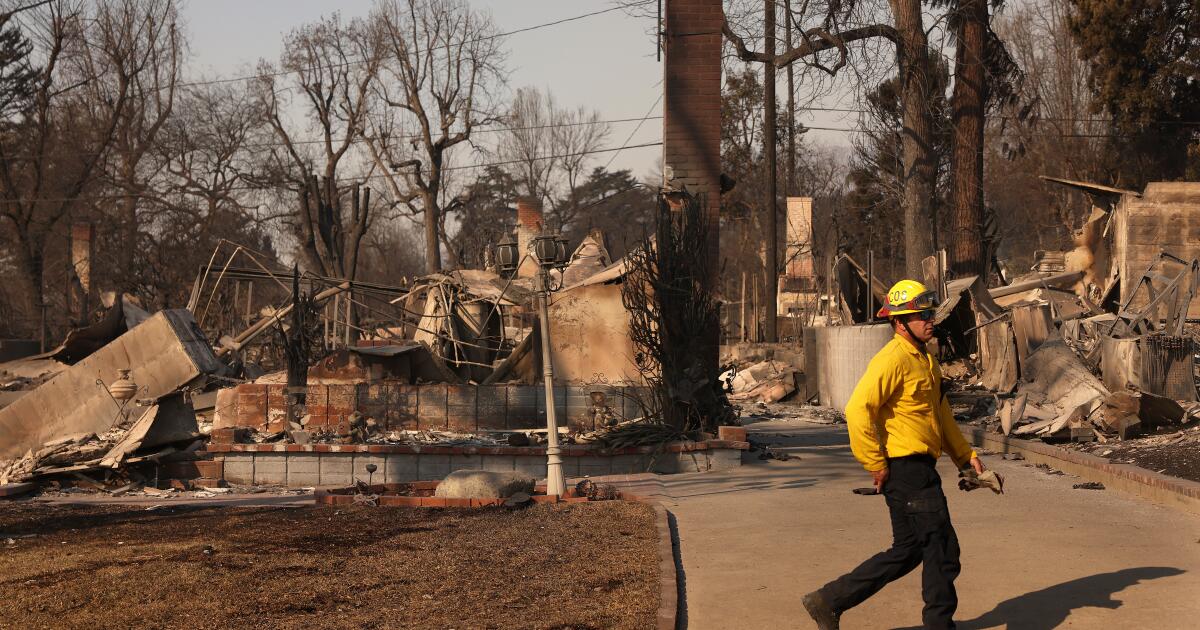Los Angeles Fires Leaves Many Homeowners Without Insurance Coverage
‘A train wreck coming down the track’
Francis Bischetti, a 55-year-old personal assistant, learned last year that the annual cost of his homeowners policy with Farmers Insurance was going to soar from $4,500 to $18,000 – an amount he could not possibly afford. Neither could he get onto California FAIR Plan, which provides fewer benefits, because he would have to cut down 10 trees around his roof line to lower the fire risk – something else he found too costly to manage. So he decided to go bare – not buying any coverage on his home in the community’s El Medio neighborhood. He figured if he watered his property year-round, that might be protection enough given its location south of Sunset Boulevard.
It wasn’t. The home he lived in for nearly all his life burned down Tuesday along with more than 10,000 other homes and structures damaged or destroyed in the worst fire event in the history of Los Angeles. Sixteen deaths have been confirmed countywide.
“The situation has been a train wreck coming down the track for a while,” said Rick Dinger, president of Crescenta Valley Insurance, an independent brokerage in Glendale.
Not enough insurance money to rebuild
Peggy Holter spent decades as a television journalist, a peripatetic career that took her all over the world, but there was one place she called home and always returned to: the Pacific Palisades condo she moved into on Jan. 1, 1978. That all changed after Tuesday’s firestorm, when her condo burned to the ground along with the rest of the 36 units in the Palisades Drive complex.
Holter, 83, who only retired last year, is now facing uncertainty after she said State Farm didn’t renew her individual condo insurance, citing the condition of her roof. But with the loss of her documents, she isn’t sure if and when the policy lapsed – and she hadn’t yet secured a new carrier. The insurance typically covers personal belongings and a unit’s interior and provides benefits such as living expenses if a condo becomes unusable.
Her biggest question is whether she can rebuild. The homeowners association had a master policy from FAIR Plan, which totaled only $20 million. That would pay out only about $550,000 per unit if the complex were not rebuilt – far below the $1 million-plus the condos commanded in recent sales. The land could be sold off to a developer.
‘We don’t cover anything in California’
Matt Knight considers himself fortunate: He and his family could have lost it all in the Eaton fire, just like Bischetti and Holter in the Palisades fire.
The trouble started last year when he received a notice from Safeco Insurance that the policy on his Sonoma Drive home in Altadena, where he lives with his wife and three children, would not be renewed due to a tree overhanging his garage. The 45-year-old Covina elementary school teacher said he dutifully trimmed the tree only to be told the ivy growing on the garage also was a problem. After removing that, he said he was told he had to fix his damaged stucco, which forced him to paint his house and in the process replace his old roof. Yet he said he still couldn’t get insurance after spending $30,000 on the repairs.
A spokesperson for Safeco, a subsidiary of Liberty Mutual, said the carrier does not comment on individual policyholders.
“So we went looking company after company after company, and some of them would say, ‘No, we don’t cover anything in California.’ Some said, ‘We’re not doing any new policies.’ Some said, ‘No, we don’t do 91001 because it’s in a fire zone, and we were like, ‘That’s crazy.’”
Just a day before his policy was set to expire last summer, Knight said he finally managed to secure similar coverage with Aegis Insurance. But in the haste to get the policy in force, the home he has lived in for 16 years was left wildly under-insured for less than $300,000. The home is valued at $1.13 million on Zillow.
Conclusion
The devastating fires in Los Angeles have left many homeowners without insurance coverage, and the crisis in the state’s home insurance market is expected to worsen. The situation is dire, with many insurers dropping policies and refusing to renew them, citing the high risk of wildfires in California. The state’s largest home insurer, State Farm General, announced in March it would not renew 30,000 homeowner and condominium policies – including 1,626 in Pacific Palisades – when they expired.
Frequently Asked Questions
Q: Why are insurers dropping policies in California?
A: Insurers are dropping policies due to the high risk of wildfires in California, which makes it difficult for them to cover the costs of claims.
Q: What can homeowners do to get insurance coverage?
A: Homeowners can try to get coverage from other insurers, such as FAIR Plan, or consider purchasing additional coverage to fill the gap.
Q: How can homeowners prepare for wildfires?
A: Homeowners can prepare for wildfires by creating a defensible space around their homes, using fire-resistant materials, and having a plan in place in case of an emergency.
Q: What can be done to address the crisis in the state’s home insurance market?
A: The crisis in the state’s home insurance market can be addressed by implementing measures to reduce the risk of wildfires, such as creating fire breaks and increasing funding for fire prevention and suppression efforts. Additionally, the state can work to increase the availability of insurance coverage for homeowners, such as by providing incentives for insurers to offer coverage in high-risk areas.


